Computing Eigenvalues of Discontinuous Sturm-Liouville Problems with Eigenparameter in All Boundary Conditions Using Hermite Approximation
Abstract
The eigenvalues of discontinuous Sturm-Liouville problems which contain an eigenparameter appearing linearly in two boundary conditions and an internal point of discontinuity are computed using the derivative sampling theorem and Hermite interpolations methods. We use recently derived estimates for the truncation and amplitude errors to investigate the error analysis of the proposed methods for computing the eigenvalues of discontinuous Sturm-Liouville problems. Numerical results indicating the high accuracy and effectiveness of these algorithms are presented. Moreover, it is shown that the proposed methods are significantly more accurate than those based on the classical sinc method.
1. Introduction
The mathematical modeling of many practical problems in mechanics and other areas of mathematical physics requires solutions of boundary value problems (see, for instance, [1–7]). It is well known that many topics in mathematical physics require the investigation of the eigenvalues and eigenfunctions of Sturm-Liouville-type boundary value problems. The literature on computing eigenvalues of various types of Sturm-Liouville problems is little and we refer to [8–15].
The use of (17) in numerical analysis is known as the sinc method established by Stenger et al. (cf. [29–31]). In [9, 15, 28], the authors applied (17) and the regularized sinc method to compute eigenvalues of different boundary value problems with a derivation of the error estimates as given by [32, 33]. In [34], the authors used Hermite-type sampling series (1) to compute the eigenvalues of Dirac system with an internal point of discontinuity. In [14], Tharwat proved that Π(q, α, β, α′, β′, γ, δ) has a denumerable set of real and simple eigenvalues.
In [35], we compute the eigenvalues of the problem Π(q, α, β, α′, β′, γ, δ) numerically by using sinc-Gaussian technique. The main aim of the present work is to compute the eigenvalues of Π(q, α, β, α′, β′, γ, δ) numerically by using Hermite interpolations with an error analysis. This method is based on sampling theorem and Hermite interpolations but applied to regularized functions, hence avoiding any (multiple) integration and keeping the number of terms in the Cardinal series manageable. It has been demonstrated that the method is capable of delivering higher order estimates of the eigenvalues at a very low cost; see [34]. Also, in this work, by using computable error bounds we obtain eigenvalue enclosures in a simple way which not have been proven in [35].
In the next section, we derive the Hermite interpolation technique to compute the eigenvalues of Π(q, α, β, α′, β′, γ, δ) with error estimates. The last section contains three worked examples with comparisons accompanied by figures and numerics with Lagrange interpolation method.
2. Treatment of Π(q, α, β, α′, β′, γ, δ)
Lemma 1. For any eigenvalue μ*, one can find N0 ∈ ℤ+ and sufficiently small ε such that μ* ∈ Iε,N for N > N0. Moreover
Proof. Since all eigenvalues of Π(q, α, β, α′, β′, γ, δ) are simple, then for large N and sufficiently small ε we have , in a neighborhood of μ*. Choose N0 such that
Theorem 2. Let μ* be an eigenvalue of Π(q, α, β, α′, β′, γ, δ). For sufficiently large N one has the following estimate:
3. Numerical Examples
This section includes three detailed worked examples illustrating the above technique. By ES and EH we mean the absolute errors associated with the results of the classical sinc method [9, 15] and our new method (Hermite interpolations), respectively. The first two examples are computed in [15] with the classical sinc method. We indicate in these two examples the effect of the amplitude error in the method by determining enclosure intervals for different values of ε. We also indicate the effect of the parameters m and θ by several choices. Also, ine eigenvalues are simple, then for sufficiently the following two examples, we observe that the exact solutions μk and the zeros of Γ(μ) are all inside the interval [a−, a+]. In the third example, we compare our new method with the classical sinc method [9]. We would like to mention that mathematica has been used to obtain the exact values for the two examples where eigenvalues cannot be computed concretely. mathematica is also used in rounding the exact eigenvalues, which are square roots. Both numerical results and the associated figures prove the credibility of the method.
Example 1. Consider the boundary value problem [15]
The application of Hermite interpolations method and sinc method [15] to this problem and the effect of θ and m at N = 20 are indicated in Tables 1 and 2. In Tables 3 and 4, we display the maximum absolute error of μk − μk,N, using Hermite interpolations method and sinc method [15] with various choices of θ and m at N = 20. From these tables, it is shown that the proposed methods are significantly more accurate than those based on the classical sinc method [15].
| μk | Sinc μk,N [15] | Exact μk | Hermite μk,N |
|---|---|---|---|
| μ1 | 0.5796031003909555 | 0.579603114810978 | 0.5796031148176034 |
| μ2 | 1.7849838911323737 | 1.7849838948888357 | 1.7849838948886403 |
| μ3 | 3.2386473557238586 | 3.238647349751419 | 3.238647349751933 |
| μ4 | 4.7705623346546995 | 4.770562335590527 | 4.770562335590518 |
| μ5 | 6.32570436013402 | 6.3257043646722515 | 6.325704364672412 |
| μk | Sinc μk,N [15] | Exact μk | Hermite μk,N |
|---|---|---|---|
| μ1 | 0.5796031148103449 | 0.57960311481097786078 | 0.57960311481097786304 |
| μ2 | 1.7849838948900418 | 1.78498389488883561160 | 1.78498389488883560884 |
| μ3 | 3.2386473497526262 | 3.23864734975141899542 | 3.23864734975141899687 |
| μ4 | 4.77056233558413 | 4.77056233559052749760 | 4.77056233559052748750 |
| μ5 | 6.325704364662005 | 6.32570436467225155153 | 6.32570436467225155387 |
| μk | μ1 | μ2 | μ3 | μ4 | μ5 |
|---|---|---|---|---|---|
| ES [15] | 1.442 × 10−8 | 3.757 × 10−9 | 5.972 × 10−9 | 1 9.358 × 10−10 | 4.538 × 10−9 |
| EH | 6.625 × 10−12 | 1.954 × 10−13 | 5.138 × 10−13 | 8.882 × 10−15 | 1.608 × 10−13 |
| μk | μ1 | μ2 | μ3 | μ4 | μ5 |
|---|---|---|---|---|---|
| ES [15] | 6.332 × 10−13 | 1.206 × 10−12 | 1.207 × 10−12 | 6.397 × 10−12 | 1.025 × 10−11 |
| EH | 2.3 × 10−18 | 2.8 × 10−18 | 1.5 × 10−18 | 1.01 × 10−17 | 2.3 × 10−18 |
Tables 5 and 6 list the exact solutions μk for two choices of m and θ at N = 20 and different values of ε. It is indicated that the solutions μk are all inside the interval [a−, a+] for all values of ε.
| μk | Exact μk | [a−, a+], ε = 10−5 | [a−, a+], ε = 10−10 |
|---|---|---|---|
| μ1 | 0.579603114810978 | [0.504287, 0.644005] | [0.579603, 0.581089] |
| μ2 | 1.7849838948888357 | [1.76837, 1.80095] | [1.78494, 1.78503] |
| μ3 | 3.238647349751419 | [3.18936, 3.28517] | [3.2375, 3.23979] |
| μ4 | 4.770562335590527 | [4.74591, 4.79495] | [4.77054, 4.77059] |
| μ5 | 6.3257043646722515 | [6.30433, 6.34704] | [6.32536, 6.32605] |
- ℰ3(ℱθ,m) = 2.61231 × 1011, ℰ2(ℱθ,m) = 4.67787 × 1010, α = 1, and .
| μk | Exact μk | [a−, a+], ε = 10−5 | [a−, a+], ε = 10−10 |
|---|---|---|---|
| μ1 | 0.57960311481097786078 | [0.130168, 0.796074] | [0.579579, 0.579627] |
| μ2 | 1.78498389488883561160 | [1.699182, 1.859482] | [1.784963, 1.785004] |
| μ3 | 3.23864734975141899542 | [3.194355, 3.282835] | [3.238636, 3.238658] |
| μ4 | 4.77056233559052749760 | [4.698242, 4.851169] | [4.770489, 4.770635] |
| μ5 | 6.32570436467225155153 | [6.287476, 6.368771] | [6.325701, 6.325707] |
- ℰ7(ℱθ,m) = 2.25863 × 1013, ℰ6(ℱθ,m) = 5.91004 × 1012, α = 1, and .
For N = 20, m = 8, and θ = 1/6, Figures 1 and 2 illustrate the enclosure intervals dominating μ1 for ε = 10−5 and ε = 10−10, respectively. The middle curve represents Γ(μ), while the upper and lower curves represent the curves of a+(μ), a−(μ), respectively. We notice that when ε = 10−10 all three curves are almost identical. Similarly, Figures 3 and 4 illustrate the enclosure intervals dominating μ2 for ε = 10−5, ε = 10−10, respectively.
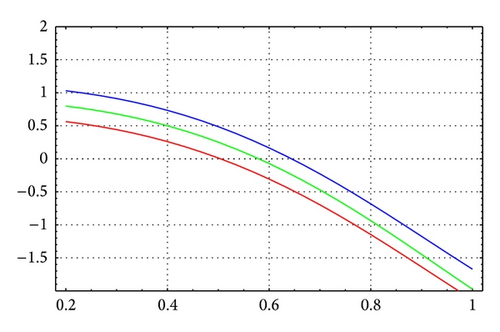
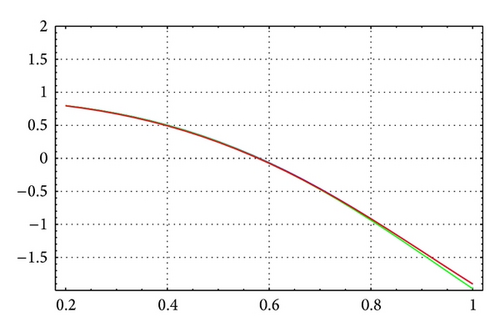
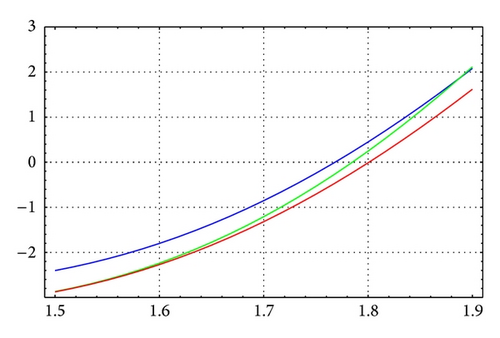

As in Table 6, for N = 20, m = 12, and θ = 1/4, Figures 5 and 6 illustrate the enclosure intervals dominating μ3 for ε = 10−5 and ε = 10−10, respectively, and Figures 7 and 8 illustrate the enclosure intervals dominating μ4 for ε = 10−5, ε = 10−10, respectively.
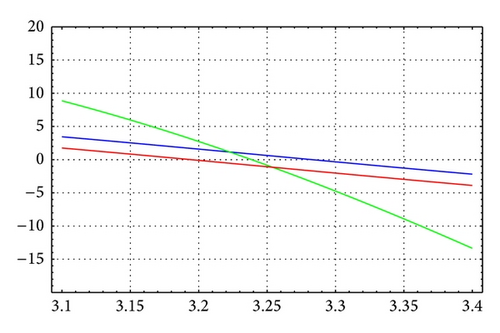
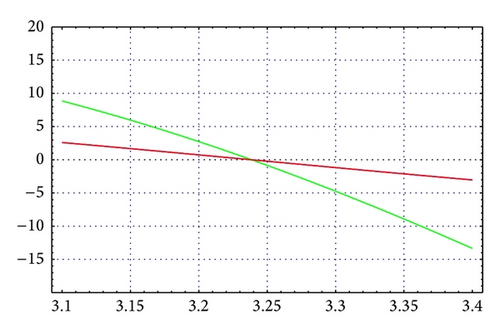
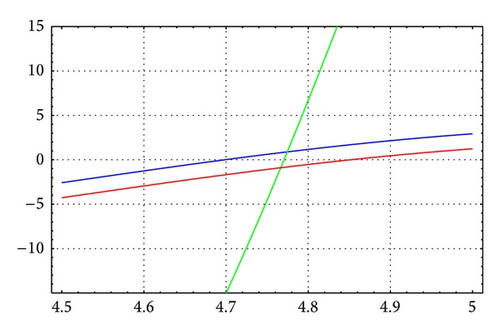
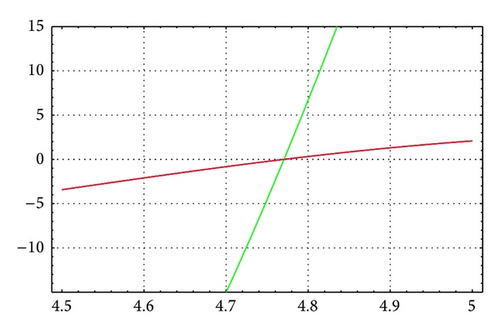
Example 2. Consider the boundary value problem
The application of Hermite interpolations method and sinc method [15] to this problem and the effect of θ and m at N = 40 are indicated in Tables 7 and 8. In Tables 9 and 10, we display the maximum absolute error of μk − μk,N, using Hermite interpolations method and sinc method [15] with various choices of θ and m at N = 40. Form these tables, it is shown that the proposed methods are significantly more accurate than those based on the classical sinc method [15].
| μk | Sinc μk,N [15] | Exact μk | Hermite μk,N |
|---|---|---|---|
| μ1 | 0.58718720635351373438 | 0.58718716772603949302 | 0.58718716772603439313 |
| μ2 | 1.67733213643112965108 | 1.67733212404977904702 | 1.67733212404977962102 |
| μ3 | 3.05318928070135885375 | 3.05318927948461569256 | 3.05318927948461567248 |
| μ4 | 4.64836948022942956741 | 4.64836948049457049728 | 4.64836948049456789884 |
| μ5 | 6.22695152015827473816 | 6.22695152029019996978 | 6.22695152029019996831 |
| μk | Sinc μk,N [15] | Exact μk | Hermite μk,N |
|---|---|---|---|
| μ1 | 0.58718716772553041066238963 | 0.58718716772603949302708573 | 0.58718716772603949300999675 |
| μ2 | 1.67733212404966397991332993 | 1.67733212404977904702706192 | 1.67733212404977904702798867 |
| μ3 | 3.05318927948463571892007113 | 3.05318927948461569256662121 | 3.05318927948461569256652760 |
| μ4 | 4.648369480494569410072581778 | 4.64836948049456789592198501 | 4.64836948049456789592198641 |
| μ5 | 6.22695152029019694414158617 | 6.2269515202901999697647050 | 6.226951520290199969764695999 |
| μk | μ1 | μ2 | μ3 | μ4 | μ5 |
|---|---|---|---|---|---|
| ES [15] | 3.863 × 10−8 | 1.238 × 10−8 | 1.217 × 10−9 | 2.651 × 10−10 | 1.319 × 10−10 |
| EH | 5.099 × 10−15 | 5.739 × 10−16 | 2.009 × 10−17 | 2.598 × 10−15 | 1.467 × 10−18 |
| μk | μ1 | μ2 | μ3 | μ4 | μ5 |
|---|---|---|---|---|---|
| ES [15] | 5.091 × 10−13 | 1.1506 × 10−13 | 2.003 × 10−14 | 1.514 × 10−15 | 3.025 × 10−15 |
| EH | 1.708 × 10−20 | 9.267 × 10−22 | 9.361 × 10−23 | 1.403 × 10−24 | 9.010 × 10−24 |
Tables 11 and 12 list the exact solutions μk for two choices of m and θ at N = 40 and different values of ε. It is indicated that the solutions μk are all inside the interval [a−, a+] for all values of ε.
| μk | Exact μk | [a−, a+], ε = 10−6 | [a−, a+], ε = 10−12 |
|---|---|---|---|
| μ1 | 0.58718716772603949302 | [0.477526, 0.667764] | [0.586774, 0.587599] |
| μ2 | 1.67733212404977904702 | [1.666867, 1.687341] | [1.677285, 1.677378] |
| μ3 | 3.05318927948461569256 | [3.046882, 3.059372] | [3.053187, 3.053190] |
| μ4 | 4.64836948049457049728 | [4.647491, 4.649246] | [4.64836924, 4.64836971] |
| μ5 | 6.22695152029019996978 | [6.226707, 6.227195] | [6.22695140, 6.22695163] |
- ℰ7(ℱθ,m) = 6.29794 × 1019, ℰ6(ℱθ,m) = 4.70791 × 1018, α = 1, and .
| μk | Exact μk | [a−, a+], ε = 10−7 | [a−, a+], ε = 10−12 |
|---|---|---|---|
| μ1 | 0.58718716772603949302708573 | [0.554227, 0.616993] | [0.587165, 0.587209] |
| μ2 | 1.67733212404977904702706192 | [1.648191, 1.703225] | [1.6773305, 1.6773337] |
| μ3 | 3.05318927948461569256662121 | [3.050775, 3.055585] | [3.05318912, 3.05318943] |
| μ4 | 4.64836948049456789592198501 | [4.647994, 4.648743] | [4.648369468, 4.648369492] |
| μ5 | 6.2269515202901999697647050 | [6.226831, 6.227072] | [6.226951509, 6.226951531] |
- ℰ11(ℱθ,m) = 1.67235 × 1024, ℰ10(ℱθ,m) = 1.44089 × 1023, α = 1, and .
For N = 40, m = 12, and θ = 1/14, Figures 9 and 10 illustrate the enclosure intervals dominating μ1 for ε = 10−6 and ε = 10−12, respectively. Similarly, Figures 11 and 12 illustrate the enclosure intervals dominating μ2 for ε = 10−6, ε = 10−12, respectively.
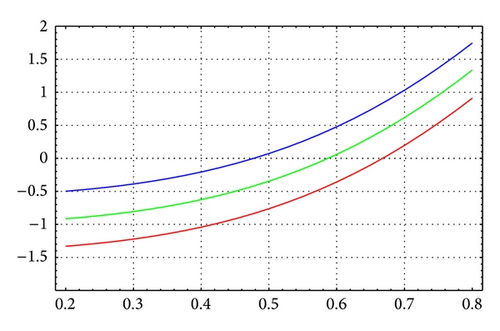
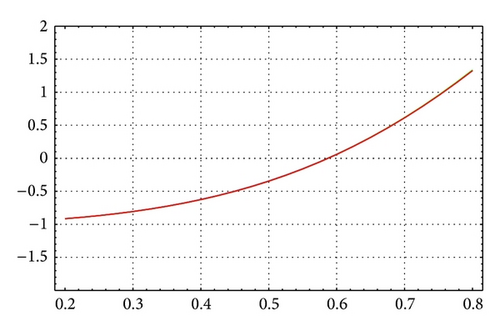
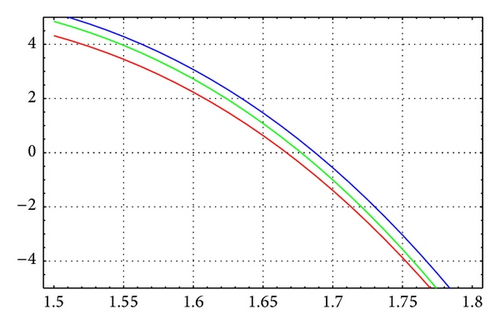
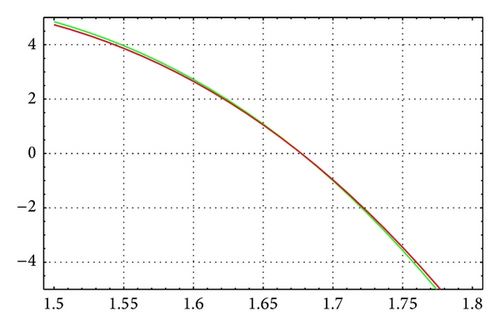
For N = 40, m = 16, and θ = 1/12, Figures 13 and 14 illustrate the enclosure intervals dominating μ1 for ε = 10−7 and ε = 10−12, respectively, and Figures 15 and 16 illustrate the enclosure intervals dominating μ2 for ε = 10−7, ε = 10−12, respectively.
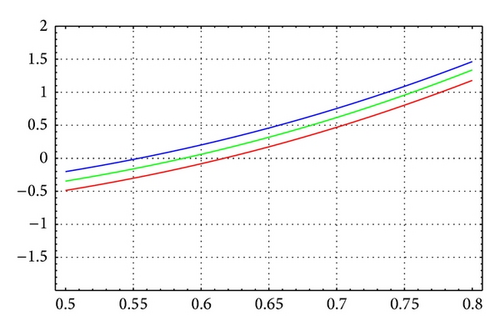
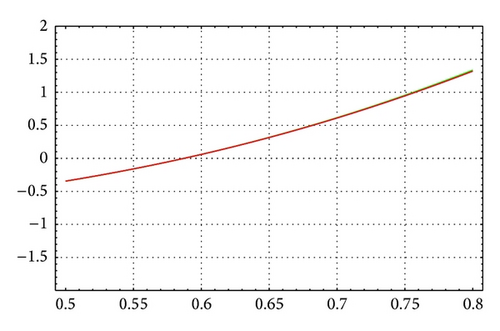
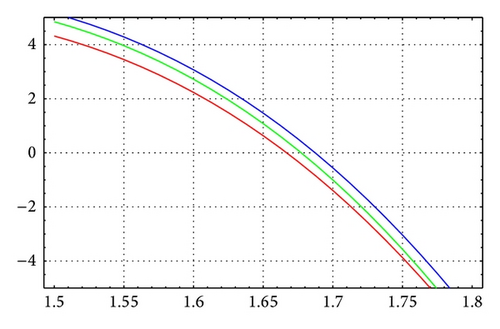
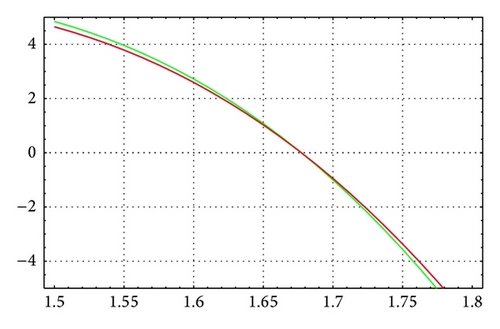
Example 3. Consider the continuous boundary value problem [9]
| μk | Sinc μk,N [9] | Exact μk | Hermite μk,N | ES | EH |
|---|---|---|---|---|---|
| μ1 | 3.119437080035764 | 3.1194369008225 | 3.1194368826279857 | 1.79213 × 10−7 | 1.81945 × 10−8 |
| μ2 | 9.421424381799804 | 9.421428536270897 | 9.421428567680044 | 4.15447 × 10−6 | 3.14091 × 10−8 |
| μ3 | 12.565198874263179 | 12.565194405126995 | 12.56519440514131 | 4.46914 × 10−6 | 1.43157 × 10−11 |
Acknowledgments
This work was funded by the Deanship of Scientific Research (DSR), King Abdulaziz University, Jeddah, under Grant no. 130-065-D1433. The authors, therefore, acknowledge with thanks DSR technical and financial support.




